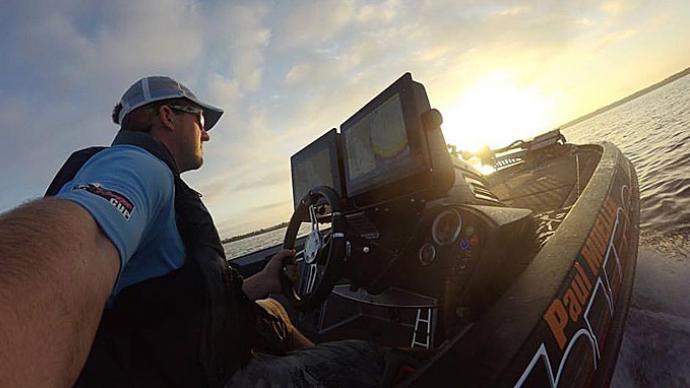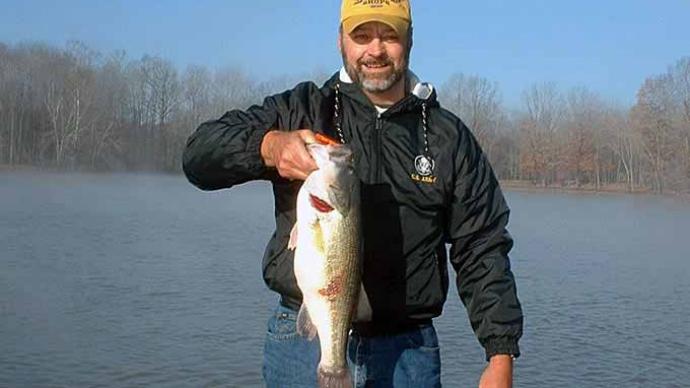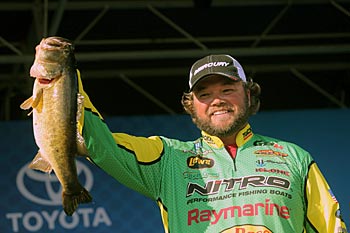
Today’s fishing electronics are modern marvels. These units, some of which have screens the size of small televisions, offer sonar views under, beside, and, in some instances, all the way around the boat. Some can bring up the weather forecast, predict tides for years in advance, and plot your exact location anywhere on Earth. It’s easy to forget that they show depth, too.
While fishing electrics provide a constant source of an almost endless amount of information, they are associated most with one season. In summer, when bass school on deep-water structure to feed, most bass anglers put them to work. The technology is vital to finding bass and then lining up perfect presentations, whether launching a deep-diving crankbait, hopping a snake-like 10-inch worm, or shaking a dainty drop shot rig. For the rest of the year, most anglers give them mere glances, checking the depth, water temperature, or return route to the ramp.
Suppose you’re lucky enough to live where lakes remain ice-free and warm up to your electronics on winter fishing trips. They’ll show you where the bass are and help you catch more of them, just like in summer. The key is knowing what to look for and where you’ll most likely find it.
Where to look
Major League Fishing angler Tim Horton has pocketed almost $2 million during his tournament career. A good portion of those winnings results from the Muscle Shoals, Ala., angler looking at his electronics.
“Summer bass orient to current,” Horton said, so he uses his electronics to search points, ledges, humps, and other open-water spots where they feed, using the moving water to their advantage. That’s especially true in reservoirs where the dam is used to generate electricity, though wind can create current on natural lakes.
Cold-blooded bass reposition when the water temperature drops. “In the wintertime, bass are more likely to get in the back of drains and deeper pockets and holes,” Horton said. “Their metabolism isn’t high enough to swim against the current.” So, he uses his Raymarine electronics to search those spots, using water clarity to define how deep he looks. The muddier the water, he said, the shallower you’ll find the bass.
Fellow Major League Fishing angler Shaw Grigsby starts his search as soon as he casts off from the dock. “I turn on my electronics when I launch,” said the Gainesville, Fla.-based angler. “I idle out of the boat ramp and am looking the whole time. I’m not jumping up on plane and running somewhere.”
Grigsby wants to find the depth range where most fish swim. That zone can change daily, primarily determined by current weather and water conditions.
Once Grigsby finds that magic range, he focuses all his efforts there. “I’m going to hunt that zone and look for [structure and cover],” he said.
What you want to see
Today’s electronics show detail like never before. Down- and side-scanning sonar, for example, will reveal each branch of a sunken brush pile, whereas traditional sonar will show the pile as one solid mass. Many anglers describe vertical fishing with these units as playing a video game. They show your lure sinking and the bass swimming over to eat it, all in real-time. All you do is wait to set the hook at the appropriate time. Bass often appear as a streak when they strike. “It’s good to see those streaks any time of year,” Horton said.
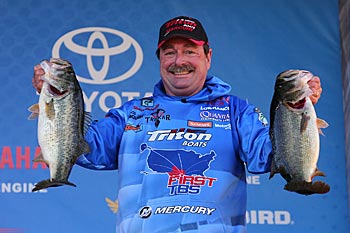
But wintertime bass aren’t always that aggressive. Their metabolism is dictated by water temperature, so they slow down when it is cold. Horton explains that sometimes you can’t see them on your electronics. “Bass will rest on the bottom during the wintertime,” he said. “They will get their bellies on the bottom and just sit, especially when they are dormant. Instead of seeing them off the bottom, they will [appear as] little bumps.”
Also, Grigsby trains his eyes on the bottom, though he isn’t necessarily watching for bass. He is looking for a bottom that his electronics depict as a wide band, which is the tell-tale sign of a hard composition. “I like rock because it takes longer to cool down,” he said. In addition to the warmth, bass are attracted to its nooks and crannies, which are home to crawfish, baitfish, and other prey. He says rock patches are incredibly productive on lakes with mostly clay or muck bottoms.
Bassmaster Elite Series angler John Crews relies on his electronics in winter nearly as much as he does in summer when he searches for brush, stumps, and other pieces of cover dotting structure that attract bass. Things are looser at the other end of the calendar. “In the wintertime, I somewhat define the structure, but [bass are] almost exclusively baitfish oriented,” he said. “That’s the key in wintertime.”
Crews, who has fished the Elite Series since its inception, said baitfish orient to the bottom when it is frigid. But most winter days, they’ll suspend near structure such as a drain, creek channel, or deep point. “That’s what I am looking for,” he said. “Where are the baitfish? What depth is the baitfish? What kind of stuff are they relating to?” Once he finds them, he finds the bass.
Baitfish appear differently depending on which scan you have selected on your electronics. They can look like giant splotches or clouds on traditional sonar. On down-scan imaging, they look like groups of specks, as if salt was sprinkled on a dark surface.
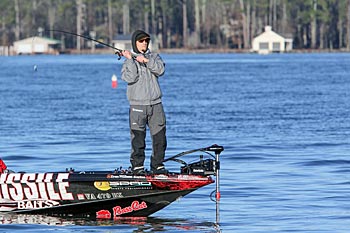
Sometimes Crews finds too many baitfish. He said fishing would be tough when whole creek arms — from bank to bank — are filled with them because bass can be anywhere. He prefers to search out smaller schools of baitfish. “Those are always better,” he said. “They concentrate bass, making them easier to target.”
Setting up your electronics
While water becomes denser as it cools, and many bass are deeper in winter than in other seasons, Grigsby said you don’t need to adjust your electronics to see them. Crews agreed: “When you get them dialed in, the water temperature doesn’t make any difference.”
Grigsby leaves his electronics on the shallow-water setting but prefers to make manual adjustments. While they’ll give you the information you need on the automatic setting, he said the most significant reason driving his preference is being able to see depth changes in proper perspective.
Say you have a drop that goes from 8 feet down to 40 feet. On automatic, the graph will rescale the picture as the depth changes. That means you’ll have to interpret the change through different views. So, Grigsby limits his unit to one depth scale that’s deeper than he is looking, in this case, 40 feet. That way, he sees the complete change in one continuous picture. “I want to see it exactly so I don’t have to figure out what the next screen means,” he said. “I get to see it as it is.”
Grigsby’s search for clarity also powers his choice in the size and quantities of his units. He uses two Lowrance HDS Carbon 12 units on his boat’s console. That allows him to dedicate one to a single function, mapping, or structure scan, which gives him a better view of the smallest detail. “Whatever the primary thing you want to look at that moment, put it on full screen,” he said. Two units also allow him to compare different views. He can pull up a different electronic map on each, for example, looking for minor changes marked on one but not the other.
On the bow, he runs an HDS Carbon 16. He mounts that unit, which sports a 16-inch screen, next to his trolling motor’s pedal. He prefers this unit because he is far from it while fishing. “I can see everything because [the screen] is so large,” he said.


